Honor Award
Your Fault
Jonathan Avila, Student ASLA; Travis Gramberg, Student ASLA and Ryan Honeybourne,
Student ASLA, California State University, Pomona
Faculty Advisors: Andrew Wilcox, ASLA and Bud Sutton
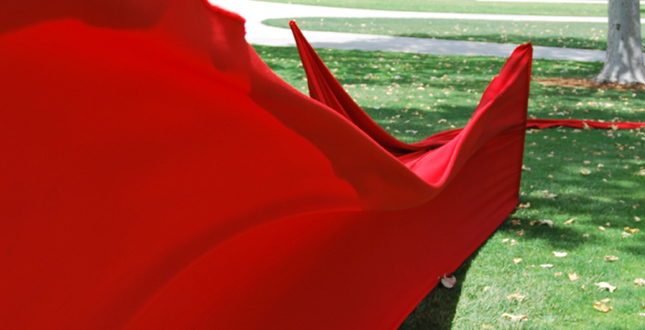 Close Me!
Close Me!Your Fault
Download Hi-Res ImagePhoto: Alex Casillas, Travis Gramberg, Ryan Honeybourne, Jonathan Avila
Photo 1 of 14
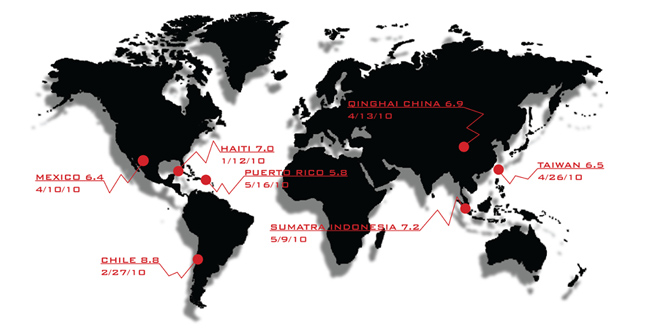 Close Me!
Close Me!Motivation for Awareness. The unpredictably of the major earthquakes in the past year that occurred in various countries around the world was the motivating factor for a landscape installation project.
Download Hi-Res ImagePhoto: Alex Casillas, Travis Gramberg, Ryan Honeybourne, Jonathan Avila
Photo 2 of 14
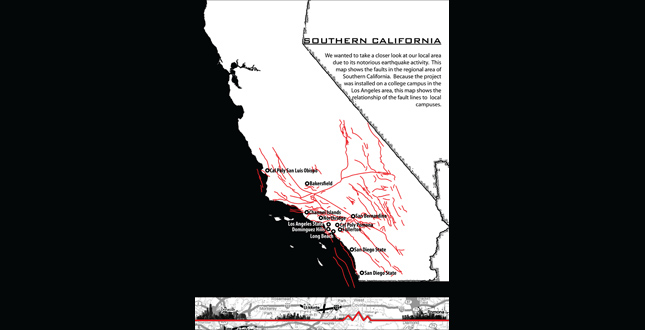 Close Me!
Close Me!Southern California. We wanted to take a closer look at our local area due to its notorious earthquake activity. This map shows the faults in the regional are of Southern California. Because the project was installed on a college campus in the Los Angeles area, this map shows the relationship of the fault lines to local campuses.
Download Hi-Res ImagePhoto: Alex Casillas, Travis Gramberg, Ryan Honeybourne, Jonathan Avila
Photo 3 of 14
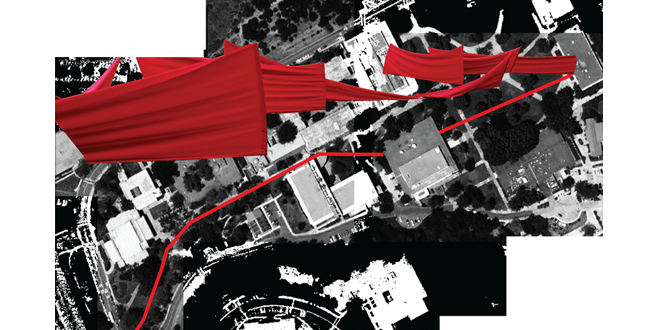 Close Me!
Close Me!1/4 Mile Though the University. The quarter mile of fabric was only a miniscule portion of the actual San Jose Fault, but the installation’s size relative to the campus gave a clear understanding of the faults path and how its activity could greatly affect campus infrastructure.
Download Hi-Res ImagePhoto: Alex Casillas, Travis Gramberg, Ryan Honeybourne, Jonathan Avila
Photo 4 of 14
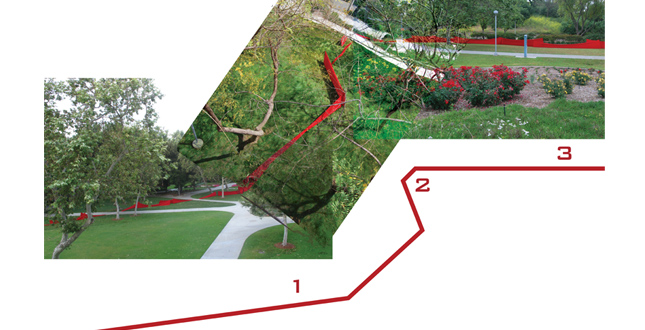 Close Me!
Close Me!The Three Zones. The three major green areas of the project site were identified with large undulating pieces of fabric. Each zone had its own special characteristics, but the project read as a single entity as one moved through the spaces on campus.
Download Hi-Res ImagePhoto: Alex Casillas, Travis Gramberg, Ryan Honeybourne, Jonathan Avila
Photo 5 of 14
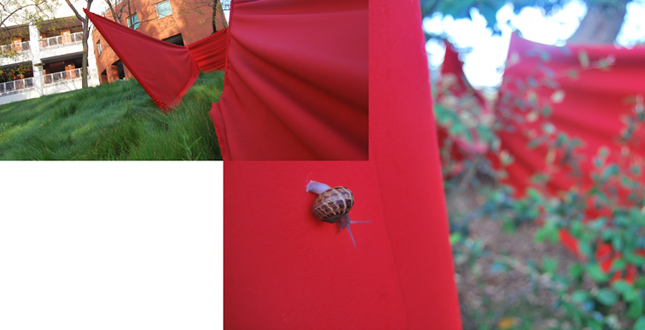 Close Me!
Close Me!Damage Control. Structures can greatly be affected by and earthquake versus nature that can adapt and conform to the shift in the earth.
Download Hi-Res ImagePhoto: Alex Casillas, Travis Gramberg, Ryan Honeybourne, Jonathan Avila
Photo 6 of 14
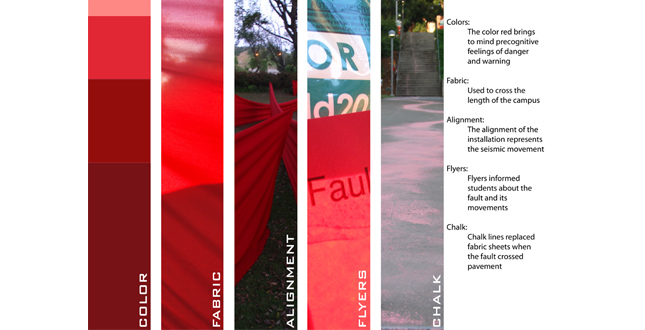 Close Me!
Close Me!The Idea. Colors: The color red brings to mind precognitive feels of danger and warning. Fabric: Used to cross the length of the campus. Alignment: The alignment of the installation represents the seismic movement. Flyers: Flyers informed students about the fault and its movements. Chalk: Chalk lines replaced fabric sheets when the fault crossed pavement.
Download Hi-Res ImagePhoto: Alex Casillas, Travis Gramberg, Ryan Honeybourne, Jonathan Avila
Photo 7 of 14
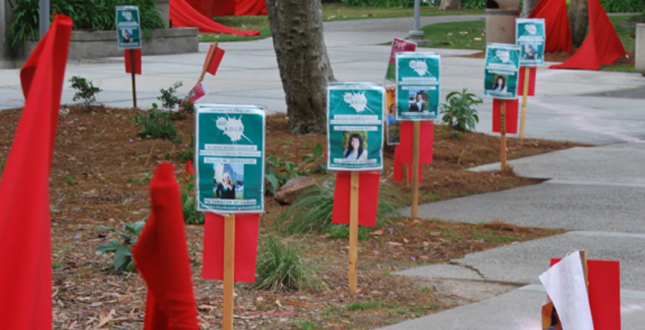 Close Me!
Close Me!Post All Bills. A series of flyers were used to inform the student population about the facts of the San Jose Fault.
Download Hi-Res ImagePhoto: Alex Casillas, Travis Gramberg, Ryan Honeybourne, Jonathan Avila
Photo 8 of 14
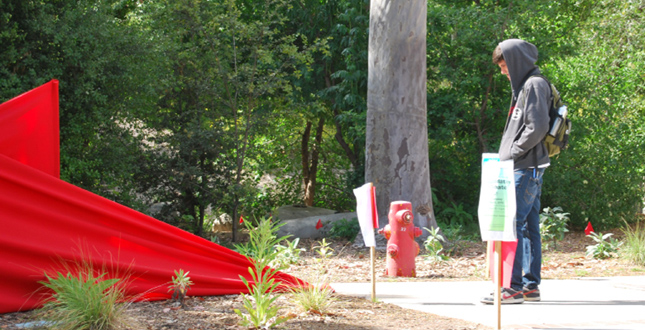 Close Me!
Close Me!Photo: Alex Casillas, Travis Gramberg, Ryan Honeybourne, Jonathan Avila
Photo 9 of 14
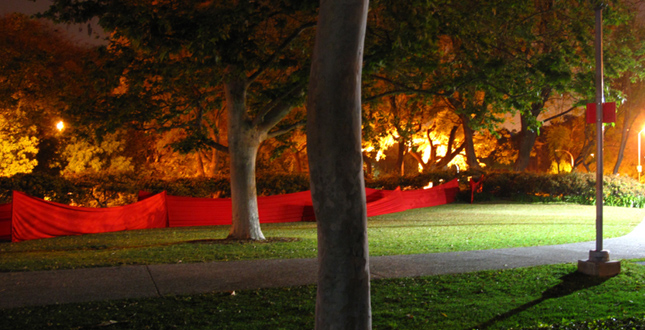 Close Me!
Close Me!Photo: Alex Casillas, Travis Gramberg, Ryan Honeybourne, Jonathan Avila
Photo 10 of 14
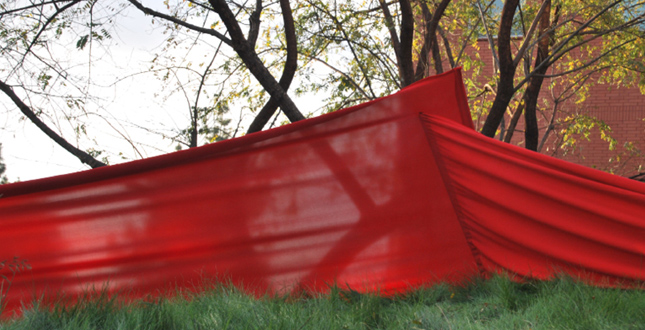 Close Me!
Close Me!Photo: Alex Casillas, Travis Gramberg, Ryan Honeybourne, Jonathan Avila
Photo 11 of 14
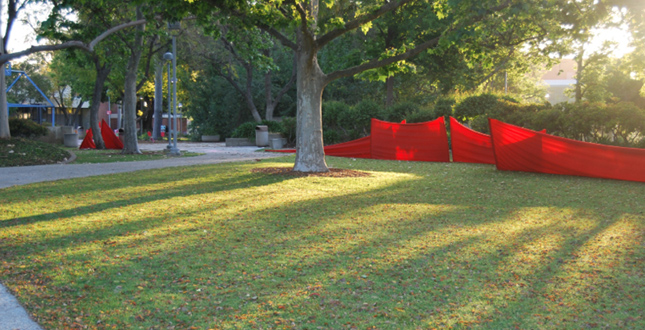 Close Me!
Close Me!Photo: Alex Casillas, Travis Gramberg, Ryan Honeybourne, Jonathan Avila
Photo 12 of 14
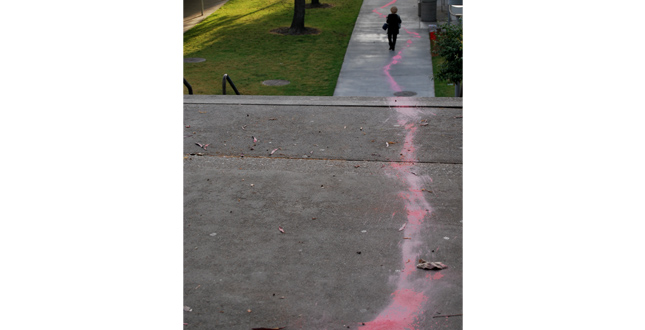 Close Me!
Close Me!Photo: Alex Casillas, Travis Gramberg, Ryan Honeybourne, Jonathan Avila
Photo 13 of 14
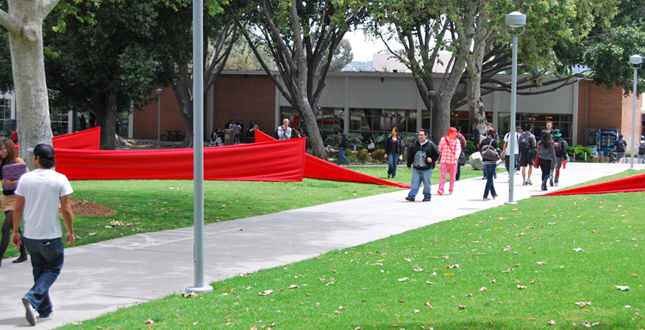 Close Me!
Close Me!Knowledge. The students became an effective method of communication. After realizing the importance of installation the students spread the word to their peers.
Download Hi-Res ImagePhoto: Alex Casillas, Travis Gramberg, Ryan Honeybourne, Jonathan Avila
Photo 14 of 14
Project Statement
The inspiration for the San Jose earthquake fault project arose from the large amount of high magnitude earthquakes that have been on the rise around the world. The temporary land art installation was designed to bring awareness to a student community about the actual fault lines that run through their Southern California college campus. By revealing the literal fault through a representational structure; the out of sight became a reality.
Project Narrative
The San Jose earthquake project was based off the tragic earthquakes that recently happened in Chile, Haiti, and China which have taken so many lives. These earthquakes were the inspiration to bring attention to the smaller faults that exist in Southern California. These smaller faults run beneath much of the infrastructure that makes life possible in the Los Angeles region. This infrastructure includes universities, hospitals, roads, and bridges. For this installation the focus was turned towards universities because these institutions house the future politicians, doctors, architects and teachers that could be vulnerable due to an earthquake.
The San Jose fault line is a 12 mile fault that runs through part of Southern California and more specifically, the university that the project was focused on. The last major movement on the fault line was a 5.4 earthquake in 1990; however it has a possible magnitude of 6.5. The San Jose fault is a split fault which means that the ground moves laterally rather than vertically. The approach to this project was to bring the San Jose fault line to the surface where students could see it and interact with it. The goal was to invoke curiosity, and hopefully knew found knowledge among the majority of the universities students.
The project dealt with all the characteristics of the literal San Jose fault through artificial mimicry. The materials used throughout the project were chosen for specific purposes. PVC pipe, 300 yards of polyester fabric, and simple sidewalk chalk were the materials chosen to carry out the installation. The fabric was cut into different length sheets and sleeves were sewn at the end. The PVC was pounded into the ground and then inserted into the sleeves at the ends of the fabric sheets. The fabric was strategically positioned in an undulating manner across all of the planter and lawn areas on the campus to give the illusion of two terrestrial plates grinding together. The entirety of the fabric portion of the installation was 900 feet from beginning to end; however, when the fault crossed through pavement, it was replaced by a line of powdered chalk to provide the understanding that the fault is a continuous geological feature.
The core of this project was to inform students about the fault lines that run through the heart of their campus. Fault lines should not be forgotten; rather, they should be understood and made an integral part of urban design. After all, it is Your Fault.
Additional Project Credits
Filming & Editing
Richard Krumm
Installation Team
Ryan Honeybourne, Travis Gramberg, Jonathan Avila, Alex Casillas, Richard Krumm, Ryan Brisbin, & Coral Withsosky
Sewing Team
Laurie Honeybourne, Irma Avila, Samantha Avila





